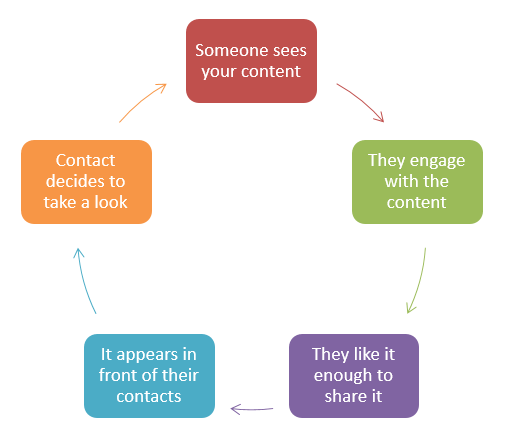Firstly I’m going to apologise for the headline, it’s the type of clickbait that is becoming increasingly common in our media. However, I’m hoping that you’ll forgive it considering the subject matter – virality. Don’t worry, if you’re only after the ‘rules’… they follow the science bit.
What is Virality?
Virality refers to something being viral, in this instance a piece of content and the tendency of that piece of content to be shared rapidly and widely across the internet. The process behind virality or the virality loop (below), as it is known is the Holy Grail for many marketers hoping to snag themselves a viral hit.

What makes something go viral?
In its simplest terms, virality is achieved when 2 factors combine:
- When the number of shares per person in any 1 loop is above 1 (virality coefficient)
- When there is a short amount between someone seeing and sharing the content (cycle time)
The ideal is a piece of content that has a high virality coefficient and a short cycle time, so that each person that sees it shares it with many people, and does so very quickly so the content achieves a huge reach in a short space of time.
What are the ‘rules’ of virality?
While there aren’t any hard and fast rules to what makes something go viral, there are some important guidelines to consider if you want to maximise your chances.
1. Create emotion
You must create emotion with your content, without emotion nobody will be triggered into sharing it, you can create emotion by:
- Annoying people – using injustice or rights abuses and triggering their sense of social justice.
- Using cute animals – it may seem like an obvious ploy but images of cats, dogs and sloths really do drive engagement.
- Tapping into nostalgia – let people reminisce and tap into their childhood memories to spark emotion.
- Make it funny – humour elicits an emotional response and so encourages sharing.
- Use what is topical – recent events and hot topics already have huge amounts of emotion surrounding them so make the most of it.

2. Don’t get hung up on being original
Coming up with genuinely new ideas is difficult and when it comes to virality, it pays to learn from what has been successful. Spend time studying popular pieces of content and identify how you could use similar content or, if you can ignore your plagiarism scruples, use content that has been successful previously and simply bring it to a new audience.

3. Make people look cool
Ultimately nobody will share something with their friends and family if there is a risk it will harm their reputation, it’s one of the reasons pornography is rarely shared on Facebook. Any content you produce has to make your audience comfortable with sharing it. Whether it’s a political viewpoint, a picture of a cute animal or a video about toys from the eighties, if it doesn’t align with a person’s identity or character, they won’t share it.

4. Virality works in clusters
Understand the ways pieces of content spread between people. I have friends from university, the office and schooldays and in most cases I am the only link between these groups. If a piece of content is going to reach all of these groups, then I am the key link and have to see the piece of content in order to share it. The lesson here for marketers is to maximise the chances of any individual seeing a piece of content, be that posting it multiple times, or recycling content that has already proven successful in other groups.

5. Learn from data
Successful virality practitioners like Buzzfeed know the value of identifying the popular pieces of content through data on views, likes, shares and other metrics. By understanding which headlines, subject matter, images and posts are popular, you can replicate what has been most successful, learning over time what will be most successful with your target audience.

6. Quantity will lead to quality
Produce content and lots of it. Of course if you’re going to amass data then you’ll need plenty of content to push out there and measure. You shouldn’t be afraid to try different angles and plans either as the more you can test, the more you will understand what is most likely to be shared.

7. Don’t underestimate the power of the list
Notice the title? Well there’s a reason for using a number at the start. People’s brains are hardwired to understand lists as they breakdown information quickly and succinctly. Also don’t be afraid to stack your lists high, if you can find 37 reasons why Kanya West shouldn’t play Glastonbury then use them, as you increase the chance of those reasons resonating with your audience.

8. Play to people’s egos with self-indulgence
On the whole we’re selfish and are always interested in finding out more about ourselves, the number of “Which Disney/Hobbit/Game of Thrones Character are you?” quizzes that pop up in Facebook feeds is testament to that. But it isn’t just about quizzes, if you’re audience is digital marketers, tap into that identity in the title (see above).

9. Focus on the shares
Finally, if you are going to achieve virality, and have a piece of content that has a positive coefficient then you need to think from the beginning about how you are going to get people to share it. To that end, I invite you to take a look at the share buttons below and do the decent thing.

